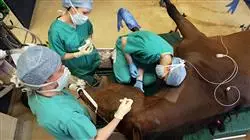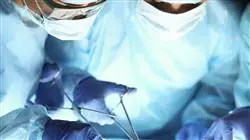University certificate
The world's largest faculty of veterinary medicine”
Introduction to the Program
Become one of the most demanded professionals of the moment thanks to the completion of this very complete Advanced master’s degree online”

In the last 20 years, veterinary anesthesia in large species has experienced great progress thanks to the introduction of new techniques and drugs, as well as the development of specific anesthetic monitors and machines.
Additionally, the introduction of new surgical techniques has created the need to develop new anesthetic protocols, and there is a growing concern about the impact of anesthesia and analgesia on animal welfare and on the final outcome of surgical procedures.
High skills in anesthesia management are essential for veterinary surgeons, since anesthetic techniques are closely linked to surgical interventions.
Therefore, in this Advanced master’s degree the main contents related to anesthetic techniques and the main tools for diagnosis, treatment and orthopedic intervention in large species, such as ruminants (cattle and sheep), camelids (camels, alpacas and llamas), swine (pigs and wild boars) and equids (horses, donkeys and mules), including the description of the main musculoskeletal and rehabilitation surgical interventions, are united in this Advanced master’s degree.
It’s necessary to take into account that this specialized course is aimed at professionals who generally have long working days, which prevents them from being able to continue with their specialization in face-to-face classes and who cannot find high quality online courses adapted to their needs. In this context of the need for competent and quality online specialization, we present this Advanced master’s degree in Anesthesia and Orthopedic Surgery in Large Species , which has come to revolutionize the world of veterinary specialization, both for its contents, as well as for its teaching staff and its innovative teaching methodology.
Furthermore, as it is a 100% online specialization, the student decides where and when to study. Without the restrictions of fixed timetables or having to move between classrooms, this course can be combined with work and family life.
A specialization created for professionals who aspire to excellence and that will allow you to acquire new skills and strategies in a fluent and efficient way”
This Advanced master’s degree in Anesthesia and Orthopedic Surgery in Large Species contains the most complete and up-to-date scientific program on the market. The most important features include:
- The latest technology in online teaching software
- A highly visual teaching system, supported by graphic and schematic contents that are easy to assimilate and understand
- Practical cases presented by practising experts
- State-of-the-art interactive video systems
- Teaching supported by remote education
- Continuous updating and retraining systems
- Self-organised learning which makes the course completely compatible with other commitments
- Practical exercises for self-evaluation and learning verification
- Support groups and educational synergies: Questions to the expert, discussion forums and knowledge
- Communication with the teacher and individual reflection work
- Content that is accessible from any, fixed or portable device with an Internet connection
- Databases of supplementary materials are permanently available, even after the completing the program
We give you the opportunity to take a deep and complete dive into the strategies and approaches in Anesthesia and Orthopedic Surgery in Large Species "
Our teaching staff is made up of working professionals. In this way we ensure that we deliver the educational update we are aiming for. A multidisciplinary staff of trained and experienced professionals from a variety of environments, who will develop theoretical knowledge in an efficient manner, but above all, will bring their practical knowledge from their own experience to the course.
The efficiency of the methodological design of this master's degree, enhances the student's understanding of the subject. Developed by a multidisciplinary team of e-learning experts, it integrates the latest advances in educational technology. In this way, you will be able to study with a range of easy-to-use and versatile multimedia tools that will give you the necessary skills you need for your specialization.
The design of this program is based on Problem-Based Learning, an approach that sees learning as a highly practical process. To achieve this remotely, we will use telepractice learning. With the help of an innovative interactive video system, and learning from an expert, you will be able to acquire the knowledge as if you were actually dealing with the scenario you are learning about. A concept that will allow you to integrate and fix learning in a more realistic and permanent way.
This specialization comes with the best didactic material, providing you with a contextual approach that will facilitate your learning"

This 100% online Advanced master’s degree will allow you to combine your studies with your professional work while increasing your knowledge in this field"
Why study at TECH?
TECH is the world’s largest online university. With an impressive catalog of more than 14,000 university programs available in 11 languages, it is positioned as a leader in employability, with a 99% job placement rate. In addition, it relies on an enormous faculty of more than 6,000 professors of the highest international renown.

Study at the world's largest online university and guarantee your professional success. The future starts at TECH”
The world’s best online university according to FORBES
The prestigious Forbes magazine, specialized in business and finance, has highlighted TECH as “the world's best online university” This is what they have recently stated in an article in their digital edition in which they echo the success story of this institution, “thanks to the academic offer it provides, the selection of its teaching staff, and an innovative learning method aimed at educating the professionals of the future”
A revolutionary study method, a cutting-edge faculty and a practical focus: the key to TECH's success.
The most complete study plans on the university scene
TECH offers the most complete study plans on the university scene, with syllabuses that cover fundamental concepts and, at the same time, the main scientific advances in their specific scientific areas. In addition, these programs are continuously being updated to guarantee students the academic vanguard and the most in-demand professional skills. In this way, the university's qualifications provide its graduates with a significant advantage to propel their careers to success.
TECH offers the most comprehensive and intensive study plans on the current university scene.
A world-class teaching staff
TECH's teaching staff is made up of more than 6,000 professors with the highest international recognition. Professors, researchers and top executives of multinational companies, including Isaiah Covington, performance coach of the Boston Celtics; Magda Romanska, principal investigator at Harvard MetaLAB; Ignacio Wistumba, chairman of the department of translational molecular pathology at MD Anderson Cancer Center; and D.W. Pine, creative director of TIME magazine, among others.
Internationally renowned experts, specialized in different branches of Health, Technology, Communication and Business, form part of the TECH faculty.
A unique learning method
TECH is the first university to use Relearning in all its programs. It is the best online learning methodology, accredited with international teaching quality certifications, provided by prestigious educational agencies. In addition, this disruptive educational model is complemented with the “Case Method”, thereby setting up a unique online teaching strategy. Innovative teaching resources are also implemented, including detailed videos, infographics and interactive summaries.
TECH combines Relearning and the Case Method in all its university programs to guarantee excellent theoretical and practical learning, studying whenever and wherever you want.
The world's largest online university
TECH is the world’s largest online university. We are the largest educational institution, with the best and widest online educational catalog, one hundred percent online and covering the vast majority of areas of knowledge. We offer a large selection of our own degrees and accredited online undergraduate and postgraduate degrees. In total, more than 14,000 university degrees, in eleven different languages, make us the largest educational largest in the world.
TECH has the world's most extensive catalog of academic and official programs, available in more than 11 languages.
Google Premier Partner
The American technology giant has awarded TECH the Google Google Premier Partner badge. This award, which is only available to 3% of the world's companies, highlights the efficient, flexible and tailored experience that this university provides to students. The recognition as a Google Premier Partner not only accredits the maximum rigor, performance and investment in TECH's digital infrastructures, but also places this university as one of the world's leading technology companies.
Google has positioned TECH in the top 3% of the world's most important technology companies by awarding it its Google Premier Partner badge.
The official online university of the NBA
TECH is the official online university of the NBA. Thanks to our agreement with the biggest league in basketball, we offer our students exclusive university programs, as well as a wide variety of educational resources focused on the business of the league and other areas of the sports industry. Each program is made up of a uniquely designed syllabus and features exceptional guest hosts: professionals with a distinguished sports background who will offer their expertise on the most relevant topics.
TECH has been selected by the NBA, the world's top basketball league, as its official online university.
The top-rated university by its students
Students have positioned TECH as the world's top-rated university on the main review websites, with a highest rating of 4.9 out of 5, obtained from more than 1,000 reviews. These results consolidate TECH as the benchmark university institution at an international level, reflecting the excellence and positive impact of its educational model.” reflecting the excellence and positive impact of its educational model.”
TECH is the world’s top-rated university by its students.
Leaders in employability
TECH has managed to become the leading university in employability. 99% of its students obtain jobs in the academic field they have studied, within one year of completing any of the university's programs. A similar number achieve immediate career enhancement. All this thanks to a study methodology that bases its effectiveness on the acquisition of practical skills, which are absolutely necessary for professional development.
99% of TECH graduates find a job within a year of completing their studies.
Advanced Master's Degree in Anesthesia and Orthopedic Surgery in Major Species
The veterinary field is a highly demanding sector, especially in the surgical field, in which pressure and complex decision making are a constant on a daily basis. In TECH Global University we understand the above mentioned, so we designed the Advanced Master's Degree in Anesthesia and Orthopedic Surgery in Major Species with the aim of boosting the capabilities of professionals through updated thematic axes and focused on the main needs of the labor market. In our 1,500 academic hours program, you will access a sophisticated curriculum, which has been specifically structured for you to develop new anesthetic protocols, deepening in animal welfare and in the final outcome of surgical procedures.
The best postgraduate degree in anesthesia and orthopedic surgery in major species
The TECH program has a highly prepared and experienced faculty. Through their guidance you will be properly qualified in the following topics: applied physiology, developmental diseases, preoperative aspects and fracture repair, as well as other topics that will be essential for you to perform correctly in daily practice. In addition, upon graduation you will have the necessary skills to lead complex operative procedures, in which you will apply the latest veterinary studies and tools to ensure the success of the process and the safety of the patient in question.







